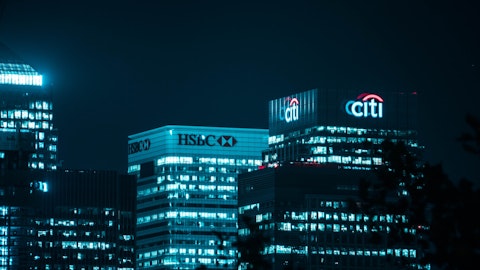So that allowed us as a platform to go to that sponsor and say, we can underwrite the entire deal give you a commitment for the entire financing, so you can go win at sell-side auction. And that’s exactly what we did. GSBD got an allocation to that. And so that’s how we go to market now.
Finian O’Shea: Okay. So if I combine – if I take this, you can do larger deals, and I think you were in the commentary, you also flagged like the non-accrual as a pre-integration credit. Does this mean you’re going to move up in EBITDA in a meaningful way?
Alex Chi: Now look, that’s something we could explore at some point in the future. But as I mentioned, in terms of the criteria for the size that we stuck to for GSBD, it’s really up to businesses with EBITDA of up to $200 million. And so that’s why you just really haven’t seen the EBITDA move up meaningfully. It ticked up a little bit in the fourth quarter, but it’s still in and around the $50 million, $55 million EBITDA range for the portfolio within GSBD. We have other pockets of capital that can pursue large cap as well as mid-market at the same time. GSBD is just – we’ll always be focused on – we’ll continue to be focused on middle market.
Finian O’Shea: Okay. That’s helpful. And last one for me on this thread. The other two Group’s historically sourced origination from the investment bank sponsor coverage, leverage finance, et cetera. Is that going to bring the BDC franchise, does that come into that fold, are we now going to source from the investment bank?
Alex Chi: So first of all, I appreciate that it’s certainly an advantage to have the investment bank, they’re originating investment opportunities for us. But still, the vast majority of the deals that we’ve originated are really directly off the platform. Having said that, we get a tremendous amount of referrals that come in from investment banking, from Private Wealth, they cover the largest family of enterprises in the world. If you look at just over the course of the year, where we had the full-year of the benefit of integration, roughly about a third of new deals that we did within GSBD, came from this one Goldman Sachs advantage as we’ll talk about. So we’re not certainly relying upon banking to source for us, but it certainly provides additional flow and allows us to be a lot more selective about what we choose to do.
Finian O’Shea: Awesome. Thanks so much.
Alex Chi: Thanks, Fin.
Operator: We’ll go next to Arren Cyganovich with Citi.
Arren Cyganovich: Thanks. I think you mentioned in your prepared remarks that you’re seeing kind of activity or expecting activity to pick up in expectations for spreads to tighten. Are you seeing, from a competitive standpoint, banks reentering into lending? Or is this still primarily just the direct lenders that you are competing with?
Alex Chi: So we’re certainly seeing the BSO market reopening. We have our own leverage finance department within banking that’s certainly active. But what we’re also seeing is that that’s really a large cap phenomena. So we have our own large-cap vehicles, and we’re certainly seeing additional competitive pressure from that standpoint. In addition to the large amount of private capital that’s just been raised overall. But we had not seen banks really get back into the core middle market, which is where GSBD plays. So although we have seen a bit of spread compression over the course of the year and quarter-over-quarter, it has not been to the magnitude of what we’ve seen on the large cap side of the business.
Arren Cyganovich: Okay. And then you had mentioned that you had I think one company that had dip in EBITDA, but from a broader perspective in your portfolio companies, are you seeing continued EBITDA growth? Or is that starting to slow or something?
Alex Chi: We’re certainly seeing continued EBITDA growth. So if you look at the fourth quarter on an LTM basis, our topline for the portfolio grew on a weighted average basis, about 16.5%. And on an EBITDA basis, it grew about 7.5%. But what’s also interesting is if you look at EBITDA margins quarter-over-quarter, we’re certainly seeing how our portfolio companies are passing along price increases to their customers. So EBITDA margin has actually expanded about 130 basis points in the fourth quarter over the third. So we were really happy to see that.
Arren Cyganovich: That’s helpful. Thank you.
Alex Chi: Thank you.
Operator: We’ll go next to Mark Hughes with Truist.
Mark Hughes: Yes. Thank you. Good morning.
Alex Chi: Good morning.
Mark Hughes: Just looking at your spread of rating, just looking at the percentage of the portfolio, kind of the one through four, little bit of movement in there, still high quality, but a little bit of erosion. Is that kind of the higher for longer, just interest coverage issue? What would account for a little bit of movement? And then do you think that’s kind of hit it, its worst. Is it – should it stabilize from here given the interest rate environment, given the economy? How do you see that?
Alex Chi: I think with respect to the portfolio, there might be some movements from name to name. But in terms of the overall quality of the portfolio, we really haven’t seen much movement. It’s actually quite stable. As you saw, we moved one name reading two to reading three, and we took a mark on that particular position. But we also moved a number of names off of non-accrual as well as we exit those investments, two of them and another one, actually, we put back on accrual, which is based upon good performance. So I wouldn’t call out anything idiosyncratic about our portfolio. It’s just really quarter-over-quarter just based upon the dynamics that we’ve talked about.
Mark Hughes: Understood. And then on your net investment activity sounds like more opportunities that you’re looking at, you’ve had some decent repayment activity here lately. How do you think that’s going to shake out in the near term? Is it still kind of a push or when do you start to get ahead of that?
Alex Chi: Look, in terms of activity, we remain quite optimistic about the second half of this year. Lots of different factors, which I’m sure you’ve heard of from us as well as other managers in space. But private credit continues to be driven really by private equity activity, leverage buyouts, add-on activity. It’s well known, just the sheer amount of dry powder that’s out there. In addition, there is a significant amount of company that are owned by private equity firms that really just have to be monetized. I believe last year was the second lowest amount of distributions from private equity firms to their LPs in a quarter century. So in order for private equity firms to really raise their next fund, they’re going to have to distribute capital.
So at the same time, just going back to Fin’s question, we had the benefit of speaking with our investment bankers who sell many companies to private equity firms, and they will tell us that the backlog of companies that they’ve been mandated to sell just continues to sit at near record levels. So for all those reasons, we remain optimistic. If rates do start to come down later in the year, that should signal more confidence. And so that will also just open the floodgates a bit more on M&A activity, and we will get our share of that.
Mark Hughes: Thank you.
Alex Chi: Thank you.
Operator: [Operator Instructions] We’ll go to our next question from Robert Dodd with Raymond James.
Robert Dodd: Hi, guys. On the repayment activity in the quarter, obviously, that was pretty significant, but the repayment fees accelerated OID, et cetera, were down. Was that just coincidental or was there any effort by you to encourage the – some of the older assets, which would have lower accelerated OID to migrate out of the portfolio? I mean, is this a part of the rotation or just coincidence?
Alex Chi: Yes. Hi, Robert. Yes, it’s just coincidence. I’d say last quarter, we had some investments that exited that were some larger investments with a greater amount of OID, which was unamortized some deals that had come over in the MMLC merger that had large unamortized balances, and that was really what was kind of driving up that non-recurring income last quarter. We did still see some accelerated amortization and repayment related interest income this quarter, but it just wasn’t to the magnitude coincidentally with the handful of investments last quarter with the larger balances unamortized.
Robert Dodd: Got it. Thank you. On leverage, I mean you are below target right now. I mean, obviously, with rates where they are, you don’t need to be pushing the envelope on the leverage to – to produce earnings well in excess of the dividend. But so is that – should we expect leverage to ramp up rapidly? Or is it going to be relatively rapid depending on the market and activity or is the intent to ramp it up a little slower as maybe as rates come down as kind of offset factor?
David Miller: Hey, Robert, it’s David. No, I think you’ll see us take that up slightly. I don’t think you’re going to see a rapid increase. As you know, it’s 1.25x is our target leverage. So I think you’ll see us in future quarters, probably approach that level, but it’s going to bounce around up and down a little bit from our target level depending on activity in the portfolio.
Robert Dodd: Got it. Thank you. And then on the – last one for me on the unsecured side, obviously, you don’t have maturities until 2025, 2026. But would you be looking to potentially come to market if that opens up in maybe this year to increase your unsecured mix or pre-fund the 2025? And how did that if you did, would you be looking to do that at fix rate or what, it would be a fixed rate? But would you be looking to swap that to manage the exposure to rate differentials? Or are you going to stay with your historic pattern of unsecured space fixed?
David Miller: Yes. I mean, look, we’re actively monitoring the market as you point out. We have some 2025 maturities. So I think you’ll see us address those at the right time. As far as fixed versus floating, we’re going to evaluate that at a time based on where the curve is and what’s most beneficial to our investors, depending on when we execute a transaction.
Robert Dodd: Okay. Thank you.
Operator: There are no other questions at this time.
Alex Chi: Thank you very much, everybody.
David Miller: Appreciate it. Thank you.
Operator: This does conclude today’s conference call. Thank you for your participation. You may now disconnect.



